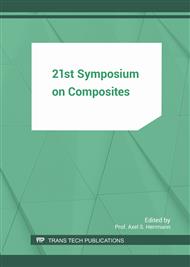[1]
S. Pimenta and S. T. Pinho, Recycling carbon fibre reinforced polymers for structural applications: Technology review and market outlook, Waste Management, doi= http: /dx. doi. org/10. 1016/j. wasman. 2010. 09. 019, (2011).
DOI: 10.1016/j.wasman.2010.09.019
Google Scholar
[2]
K. Wood, Carbon fiber reclamation: Going commercial, High-Performance Composites, (2010).
Google Scholar
[3]
Pickering 2013: www. just − auto. com/interview/recycling − carbon − fibre − composites id132685. aspx, 14. 02. (2017).
Google Scholar
[4]
M. L. Longana, N. Ong, H. Yu and K. D. Potter, Multiple closed loop recycling of carbon fibre composites with the HiPerDiF (High Performance Discontinuous Fibre) method, Composite Structures, ISSN = 0263-8223, (2016).
DOI: 10.1016/j.compstruct.2016.06.018
Google Scholar
[5]
F. Henning and E. Moeller, Handbuch Leichtbau: Methoden, Werkstoffe, Fertigung, Hanser Verlag, ISBN = 9783446422674, (2011).
DOI: 10.3139/9783446428911
Google Scholar
[6]
J. L. Leblanc, Filled Polymers: Science and Industrial Applications, CRC Press, ISBN = 9781439800430, (2009).
Google Scholar
[7]
M. Y. Zakaria, A. B. Sulong, J. Sahari and H. Suherman, Effect of the addition of milled carbon fiber as a secondary filler on the electrical conductivity of graphite/epoxy composites for electrical conductive material, Composites Part B: Engineering, 83, ISSN 1359-8368, (2015).
DOI: 10.1016/j.compositesb.2015.08.034
Google Scholar
[8]
N. Chand, A. M. Naik, Development and high stress abrasive wear behavior of milled carbon fiber-reinforced epoxy gradient composites, Polymer Composites, Volume 29, Issue 7, (2008).
DOI: 10.1002/pc.20450
Google Scholar
[9]
D. Meiners and B. Eversmann, Recycling von Carbonfasern, in K J. Thomé-Kozmiensky and D. Goldmann, Recycling und Rohstoffe, ISBN = 978-3-944310-09-1, Vivis TK Verlag, (2014).
Google Scholar
[10]
CAR FiberTec GmbH: www. car-fibertec. de/cf-flex, 14. 02. (2017).
Google Scholar
[11]
Haufler Composites GmbH & Co. KG: http: /www. haufler. com/content/carbonfaser/carbonfasermehl, 14. 02. (2017).
Google Scholar
[12]
O. Saburow, J. Hüther, R. Maertens, A. Trauth, Y. Kechaou, F. Henning, K. A. Weidenmann, A direct process to reuse dry fiber production waste for recycled carbon fiber bulk molding compounds, Elsevier, Proceedings of 1st CIRP Conference on Composite Materials Parts Manufacturing, submitted (2017).
DOI: 10.1016/j.procir.2017.03.280
Google Scholar
[13]
D. Bücheler, A. Kaiser and F. Henning, Using Thermogravimetric Analysis to Determine Carbon Fiber Weight Percentage of Fiber-Reinforced Plastics, Composites Part B: Engineering, 106, ISSN 1359-8368, (2016).
DOI: 10.1016/j.compositesb.2016.09.028
Google Scholar
[14]
M. F. Ashby, A. Wanner and C. Fleck, Materials Selection in Mechanical Design: Das Original mit Übersetzungshilfen: Easy-Reading-Ausgabe, Spektrum Akademischer Verlag, ISBN = 9783827417626, (2006).
Google Scholar
[15]
EN ISO 527-1: 1996, Kunststoffe - Bestimmung der Zugeigenschaften. Teil 1: Allgemeine Grundsätze (ISO 527-1: 1996).
Google Scholar
[16]
EN ISO 527-4: 1997, Kunststoffe - Bestimmung der Zugeigenschaften. Teil 4: Prüfbedingungen für isotrop und anisotrop faserverstärkte Kunststoffverbundwerkstoffe (ISO 527-4: 1997).
DOI: 10.31030/7360910
Google Scholar


